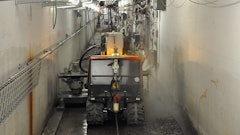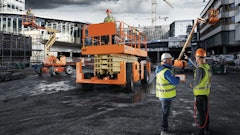
Whether it's used for lifting and placing or for digging and dumping, your telehandler will perform more productively and last longer if regular preventive maintenance is an integral part of its life.
"The more care you take, the less likely your machine will fail," says Steve Peacock, director of after sales support, Manitou.
Standard PM tasks
Like all construction equipment, the list of PM tasks includes changing filters as needed and watching fluid levels, such as engine oil, transmission fluid, hydraulic oil, etc. Be sure to use fluids recommended by the manufacturer as outlined in the machine's maintenance manual.
"Follow the directions as to what fluid ? brake fluid, coolants, oils, etc. ? you put in the machine," advises Jim Blower, mid-range product manager, JCB.
Regularly grease pins, bushings, etc. to prolong component life. "Worn pins and bushings/boom slide pads are the most common failures due to lack of grease," says Abe Wheeler, product support, Skyjack.
For machines working all day, lubrication may be needed as often as once a day, and in some situations, automatic lubrication systems can make sense. And while frequent greasing does require an investment in time and money, in the long run, it pays for itself. "Spend a few dollars for grease, rather than hundreds or thousands of dollars for a new cylinder or axle or whatever component wears outs," says Peacock.
Components such as chains on a lift and place machine will need to be adjusted. "Make sure all the chains are under the same amount of tension. If one stretches and the other doesn't, then you shift the load onto just one chain," says Blower. "When one chain does all the work and suddenly fails, it puts a shock load onto the second chain. Then that one can fail because of the shock load and the whole thing can come down."
The parking brake is another area that is commonly overlooked. Check the cable and adjust it if necessary to ensure it will work when needed.
And don't forget to check the tires. "Tires are probably one of the more common wear items on telehandlers," says Brian Boeckman, JLG, "especially if the machines are being used on hard surfaces such as concrete or asphalt."
If you're renting the machine, determine who is responsible for PM tasks. "A few rental houses do service their own equipment, rather than relying on the renter," says Blower. But if the responsibility falls onto you, make sure it's included in the operator's routine. "If one of the main pivots seizes on a rental unit, and the rental company can prove that it's due to a lack of maintenance, you can be held responsible for the repairs."
Some technologies to assist with maintenance are beginning to make their way into the telehandler market. For example, JCB's Live Link is a GPS analog cell phone technology system that enables owners/operators to communicate with a machine from the office. They can monitor information such as hours, fluid levels, etc., and set the system to indicate when a particular service is due.
"Then you can get the parts ready and go out to the machine when it's due," says Blower. "You can be prepared. This is some of the newest technology that helps keep the machines working. If you know when a particular service is due, the manager can set up the truck with all the necessary parts and be prepared. You don't have to wait for the operator to call in. It's just more proactive."
Above and beyond
There are certain jobsite conditions that may require you to go beyond the standard PM requirements.
"Any machine within the construction industry will have a maintenance schedule based on an optimum machine doing optimum work with an optimum operator in optimum climate conditions," says Peacock. "But there may be a requirement by the user to modify maintenance for some applications."
Jobsites that are particularly dusty, muddy and/or extremely hot or cold will require maintenance above and beyond what is outlined in a given maintenance manual.
For equipment working routinely in deep mud or concrete, or in very wet environments, you will want to focus extra attention on the drivetrain. "Make sure you're washing out any dirt, concrete or debris that accumulates in the steering joints," advises Blower.
"Also check to ensure that mud and/or water isn't washing out the grease from the drivetrain components," adds Wheeler.
In very dusty environments, take into consideration extremely fine particles that can work their way through worn seals, ripped boots and other protective devices and into components, notes Wheeler. "This can lead to an excessively abrasive situation that can cause early component wear," he says. "Dust or sand can also stick to grease. Also, never used compressed air to clean an air filter as this can cause small tears in the paper element, allowing dust into the engine."
If you're working on a site with a lot of debris, be sure to check the radiator frequently. "The radiator may need more frequent cleaning on these jobsites," says Boeckman. "Sand, grit or other abrasive particles can also impact boom pad wear. And if dirt or water gets into the fuel system, it can cause damage to the injection pump and injection nozzles."
In cold climates, frigid temperatures can cause the telehandler to slow down. Be sure to give the equipment adequate time to warm up so you don't cause any damage, and use fluids designed to work in colder temperatures.
"Also, in northern climates you will have to think about cold and corrosion from road treatments," Peacock adds. "There has to be a degree of localization, typically based on climate, that can change maintenance considerations."
Operator influence
The manner in which a telehandler is operated can influence the maintenance schedule, and whether additional types of maintenance will be required. "Operators can minimize wear and tear on a machine by following the routine maintenance and inspection schedules, and by using the machine within the parameters for which it is intended," says Boeckman.
If the machine is continually overloaded, it puts extra stress onto the structures, which may cause premature wear. "Always read the load charts to see what the machine can handle in any given point in its cycle to ensure you don't overload it," Blower emphasizes.
Smooth movements are also better for the machine. "Drive and operate the unit in a smooth manner with consideration of terrain, jobsite conditions and the load," says Wheeler.
"When you're traveling, the boom should be retracted and the arm fully retracted to minimize shock," adds Peacock. "Although the machine is designed to work with the boom out, you should only do so when needed."
Use the right tools
With models designed as lift and place machines, tool carriers or ground-engaging units, it's important to pick the right telehandler for the job.
"Ground-engaging machines have high bucket breakout forces and high turbo engines to push into the ground and dig," Blower notes. "The geometry on the front of the machine is also designed for bucket power. It's similar to a wheel loader leverage system to give more bucket breakout force when you use a bucket.
"If you want to ground engage, you have to make sure you have the right machine for the job," he continues. "If you put a bucket on a lift and place machine, you could damage it. You could stretch some chains, twist booms, etc., because they're not designed for that. You really need to get the right telescopic for the job."
For tool carrier designs, make sure you use the right attachments. "Using OEM attachments is critical," says Boeckman. "Using unapproved attachments can accelerate wear on the boom, and they're unsafe since the equipment manufacturer cannot assure performance or establish range and capacity limitations. You also want to use all attachments for their intended purpose and within load capacity limits."






























